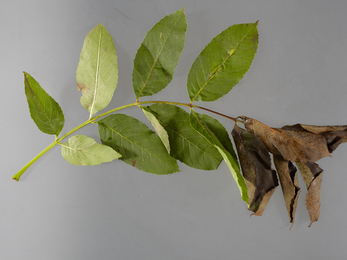Ash Dieback in Herefordshire
Ash dieback Hymenoscyphus fraxineus is a chronic fungal disease that has been spreading across the UK. It was first recorded in Herefordshire in 2015 and is now widespread in the county, being recorded in all 10km squares in Herefordshire. There is a chance that the disease will significantly alter some of our woodlands and so the Trust is taking an active interest in monitoring its spread in the county.
Symptoms of ash dieback
The first symptoms of the disease are the blackening of leaves on the tips of small branches. These are especially noticeable in saplings but also occur in bigger trees. In saplings this is followed by blackened strips on the main stem and small branches and the whole sapling soon dies. In bigger trees there may be a short resurgence of new growth. Branches soon die-back and eventually the whole tree dies.

Image: Sarang
Control of the disease
The infection is widely spread by wind-borne fungal spores and at present there is no effective way to prevent the spread of the disease. Therefore, no additional bio-security measures are being put in place on our nature reserves.
Our response
Herefordshire Wildlife Trust is very concerned about the impacts of ash dieback on our county’s woodlands and trees and we are following current best practice guidelines on ways to reduce the spread and impact of the disease.
The Trust is committed to maintaining and where possible, increasing, biodiversity in their woodlands. Active management using forestry techniques to create suitable, diverse and open structure is the most common form of intervention across our estate.
Our forestry and woodland management are undertaken to promote biodiversity but we always look to maximise income from any timber products produced as a by-product to help fund management. We have assessed the wildlife impacts of ash dieback on our infected sites and are not currently planning to proactively fell infected trees or undertake replanting with alternative species, except in areas where there is a health and safety risk around falling trees and branches and roads, such as at Queenswood Country Park.
We will continue to review the impacts but at present we believe that whilst the loss of some or all ash will have negative impacts on some specific species in our woodlands, the opening of the canopy may produce some benefits and the planting of unsuitable alternate species would compound the negative impact of ash dieback on woodland ground flora and fauna.
Queenswood Country Park & Arboretum
Queenswood lies next to the A49, one of the County’s busiest highways, and already a blackspot for accidents. Ash dieback has been recorded on site and along the A49 since 2016 and appears to be increasing. Our surveys in 2019 have found over 100 ash, of mixed sizes, within falling distance of the roadside at Queenswood. On such a busy road leaving these trees until they are badly infected is a very risky proposition. Once ash are infected there is generally a 3-5 year window before the tree starts to show high percentages of infection. Once a tree is highly infected it becomes dangerous to fell, with many dead branches, rot and hollow. Felling trees on an individual basis, using tree surgeons or Trust staff is prohibitively expensive; especially where road closures are required, as is the case with much of the A49.
With the above in mind, we have reluctantly taken the decision to proactively fell a strip of ash, and the trees growing around them, along the A49 at Queenswood.
We are hoping for this work to take place in the winter of 2020/21; we are currently seeking quotes and are investigating the road closures, that will be required, with Highways Authority.
Health and safety
We already monitor our woodlands to reduce risks to a level reasonable for a natural environment but will be undertaking an additional audit of our estate to assess for specific risks with ash.


